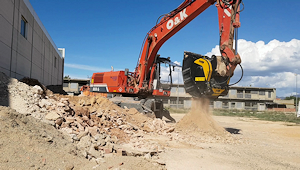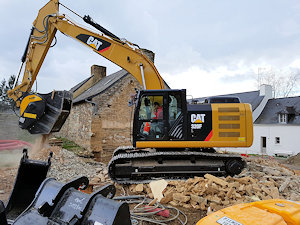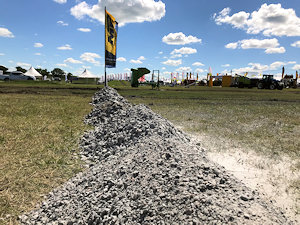The benefits of MB Crusher units towards Green Demolition
“Nothing gets thrown out! Is a lesson we have learned from our grandparents. Any scrap, can be reused, changed or repurposed to become something different. To though something out is a waste, to waste something means to lose money. In short, circular economy has always existed.
All above concepts can be applied to demolition processes, moreover when we demolish to requalify, redevelop or rebuild. Nothing gets wasted. Material is selected, processed as necessary and then reused, directly on-site or somewhere else.
A company in Spain understands this well, having recently demolished its old shed, to then build another one in its place. “Our demolition process was much more than breaking down the shed,” they stated, “it was like destroying a building made with Legos and then using the same bricks to build a new one. So, we did. What we demolished, we reused for the most part to redo the building. The bulk of the work was done by the MB Crusher’s crusher bucket, with which we crushed the inert materials to reuse them as the basis for the new shed. The job was carried out with a single heavy machine, and with a single operator, at the same yard, quickly and with a minimum investment. ” (https://www.youtube.com/watch?v=9Vt2vwshOqQ&list=PLL5YvJg_dLTMsdIVKf62RVgeYv7GNWnbw)
Building demolition: Waste only? NO, in fact, demolition is a process made up of various steps— time and cost— that represent the basis of a change. And if the demolition is done correctly with the right machinery, it became a great advantage for the company carrying it out. Sufficient to say, sustainable demolition saves about 80% of the waste from the landfill. Selective demolition—green demolition or deconstruction— it might seem more expensive, time consuming, more demanding. In reality, it saves money, time, and tax benefits.
 In France, a company managed to recycle almost all the demolition debris of an old house and reuse them to build the new one directly on the same spot, forgetting all the logistics and disposal problems.
In France, a company managed to recycle almost all the demolition debris of an old house and reuse them to build the new one directly on the same spot, forgetting all the logistics and disposal problems.
In Turkey, one excavator and one operator recovered and recycled the road demolition material – a mixture of basalt and asphalt— directly on-site and at a very low cost. How? By attaching a BF90.3 crusher bucket to his excavator, which collected the excavated material, then crushed it and made it available on site for immediate re-use. (https://www.youtube.com/watch?v=m3R4urewE8Y)
Selective demolition, therefore, is the first step towards a circular economy in which construction will give value to waste. The quality of the result depends on the type of demolition process and the machinery used for the separation and processing of the debris.
The MB Crusher product range is designed and built around these needs.
For example, if you need to have different sizes material, simply adjust the jaws of the crusher bucket or change the panels of the screening bucket directly on-site (https://www.youtube.com/watch?v=TrneX2xULCo). If you need to handle material of different types and sizes, install the right accessory on the MB-G clamps.
Anyone who uses MB machinery can gain value from the construction site waste, turning waste into quality material, converting the raw material into profit.
With the MB Crusher attachments, it is possible to maximize the recovery of the waste material, high quantity and high quality are concrete advantages: reduction of cost of transporting the waste material, reduction of the costs of transfer to landfills or treatment plants, elimination of material repurchase costs, profits obtained through the re-use or recycling of the material.
Moreover, if well managed, a sustainable demolition project has a significant impact on the state of abandonment of many urban and industrial areas. Where a dilapidated house or warehouse is demolished and replaced with a new one, there is added value, with benefits for the whole city and for the community that lives nearby.
The goal of recycling 70% of construction waste by 2020, established by the EU is possible when and where appropriate solutions are used correctly.
